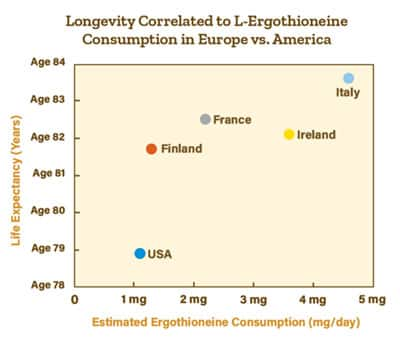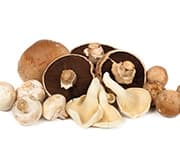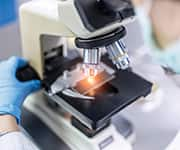Life Extension Magazine®
A landmark study published in April 2021 followed the dietary patterns of 15,000 Americans for nearly 20 years.1
Compared to no consumption, those who consumed mushrooms in their diet had a 16% lower overall mortality risk.
When one serving a day of mushrooms was ingested in place of processed or red meats, there was a 35% reduction in all-cause mortality.
A trend toward even lower mortality was found in people who consumed higher amounts of mushrooms.
So, what's in mushrooms that enables people to live longer?
It turns out that mushrooms contain more of an amino acid called L-ergothioneine than other food sources.2,3
This has spurred researchers to find out how L-ergothioneine works in the body.
As you will read, L-ergothioneine appears to protect DNA and reduce the shortening of telomeres.
The article describes the longevity benefits observed in humans who consume edible mushrooms, which contain the amino acid L-ergothioneine!
What is L-Ergothioneine?
L-ergothioneine is an amino acid not produced by the human body.5
L-ergothioneine levels peak in early adulthood and steadily decline with age as the body loses its ability to accumulate this powerful nutrient.6,7
It is found in the highest concentration in mushrooms and other fungi. Miniscule amounts are found in plants that have taken it up from the soil.
To obtain meaningful quantities, L-ergothioneine must be acquired through diet (eating lots of mushrooms) or as a standardized supplement.7-9
Unfortunately, L-ergothioneine is not commonly found in the American diet. This is largely due to low consumption of mushrooms and industrial farming practices, making supplementation the best option. It would take about 2-5 cups of the common white button mushrooms to equal 5 mg of L-ergothioneine.10,11
When L-ergothioneine intake in America was compared with intake in Europe, researchers found that Europeans had greater longevity possibly due to higher L-ergothioneine intake.12
Most tissues of the body contain L-ergothioneine.7,8 It is concentrated in higher degrees in cells at greatest risk of injury due to oxidative stress and inflammation, including blood, bone marrow, eye lens, brain, liver, and skin.7,8
L-ergothioneine transporters are also found in the placenta and mammary glands, suggesting its importance in the early development of the embryo and newborn children.7
Scientific Findings
A major finding catapulted L-ergothioneine into the scientific spotlight.
Humans produce a transporter protein that takes up L-ergothioneine from the diet and distributes it into cells throughout the body.4
Although this protein can carry other compounds, it transports L-ergothioneine 100 times more efficiently than other nutrients.
This preferential treatment given to L-ergothioneine indicates the important role it plays in the body.
Promising Studies
Observational studies have found evidence that L-ergothioneine may be critical to healthy aging. They have even shown a correlation between blood levels and overall life expectancy.
One study compared the average daily intake of L-ergothioneine among several developed countries.12
The countries with the lowest intake, such as the United States, had a lower average life expectancy.
Countries with the highest intake have a considerably longer average lifespan.
Italians, on average, ingest more than four times greater amounts of L-ergothioneine daily compared to people in the United States.12
Studies are finding that higher blood levels of L-ergothioneine are associated with lower incidence of:
- Cardiovascular disease13
- Cognitive decline/mild cognitive impairment6
- Parkinson's disease14
- Crohn's disease (an inflammatory bowel disease)15
- Frailty16
- Death from cardiovascular disease or death from any cause13
What you need to know
Defend Cells and Tissues Against Harm
- L-ergothioneine is an amino acid that is found in mushrooms and other fungi.
- The human body cannot produce L-ergothioneine, but human cells express a transporter that is highly specific for L-ergothioneine, facilitating its transport into cells and mitochondria.
- The existence of this specific transporter is highly suggestive that L-ergothioneine is an essential compound in the body. And because it has been found to play an important role in cellular protection, this has led to an explosion of medical research into the nutrient in recent years.
- Observational studies show that higher L-ergothioneine intake and blood levels correlate with longer life expectancy and reduced risk for several age-related conditions, including heart disease and cognitive decline.
Levels of L-ergothioneine also appear to be depleted in tissues that have undergone age-related injury and loss of function.
For example, people with cataracts have lower levels of L-ergothioneine than those with healthy eye lenses. The degree of the compound's depletion correlates with the severity of cataract formation.17
L-ergothioneine intake is thought to be very limited in the typical U.S. diet.12 Levels also tend to decline with advancing age.6,18,19 Oral intake can effectively raise blood levels.20
Potential Mechanisms of Protection
L-ergothioneine appears to be a normal component of a tissue's defense against injury.7,8
L-ergothioneine has a sulfur-containing group that puts it in a class related to glutathione, one of the most powerful antioxidants produced in the body.21,22
In cells, L-ergothioneine concentrates in the mitochondria, an organelle vulnerable to oxidative stress. Preclinical evidence shows that L-ergothioneine can help neutralize oxidizing compounds before they damage mitochondria and other cellular structures.23,24
Protecting Against DNA Damage
The amount of damage inflicted on cellular DNA is underestimated.
Be it background radiation or normal metabolic processes, our DNA is constantly "broken" and then "repaired" utilizing specialized coenzymes that are depleted with normal aging.
Failure to repair damaged DNA can result in cells transforming into a malignant or senescent state.
The ability of L-ergothioneine to protect DNA is promising.
For example, ultraviolet (UV) radiation damages the DNA of skin cells and accelerates aging of the skin and risk of skin cancers.
L-ergothioneine has been shown to absorb UV light at the same wavelengths that DNA does.8,25,26 This suggests that it can act as a kind of built-in "sunscreen" in skin cells. This mechanism may help prevent DNA damage and help DNA repair processes in cells exposed to UV radiation.27
Maintaining Longer Telomeres
Another contributor to the aging process is the loss of telomere structure, the protective caps on the ends of chromosomes.28
With advancing age, these structures are shortened, which is a marker of cellular aging, loss of function, and eventual cell death.
Protecting telomeres to maintain vitality has long been a focus of anti-aging research.
A study published in 2020 found that L-ergothioneine significantly reduced the rate of telomere shortening and decreased the number of short telomeres in cells exposed to oxidative stress conditions.29
These and other mechanisms explain why L-ergothioneine may help promote healthy longevity.
Evidence of Efficacy
Nutrients like coenzyme Q10 had a wealth of clinical trial data to support its benefits when introduced to Americans in 1983.
As it relates to L-ergothioneine, a natural component of mushrooms, there is a current lack of clinical data since it has not been used as a "drug" in other countries as CoQ10 was in Japan.
What we have is strong correlational data that indicate the value of boosting one's intake of L-ergothioneine by eating lots of safe, edible mushrooms or taking a standardized supplement.
A study published in April 2021 looked at 15,000 people for nearly 20 years.1 Those who consumed mushrooms in their diet had a 16% lower overall mortality risk, compared to no consumption.
When consuming just one serving a day of mushrooms in place of processed or red meats, there was a 35% lower all-cause mortality risk reduction.
This study also found a trend for people who consumed high amounts of mushrooms with even lower all-cause death rates. The authors of this 2021 published study concluded:1
"Mushroom consumption was associated with a lower risk of total mortality in this nationally representative sample of U.S. adults."
Mushrooms contain more L-ergothioneine than other food sources, which has enabled much correlational data to consider adding it to a healthy longevity program, in the form of daily mushroom ingestion and/or a supplement.
Here are some study summaries that provide tantalizing benefits in support of L-ergothioneine:
A 2020 longitudinal metabolomic study was conducted in Sweden involving over 3,200 study subjects. It showed that out of 112 metabolites measured at baseline, plasma L-ergothioneine levels were the most strongly associated with decreased risk of cardiovascular disease and reduced mortality after 21.4 years of follow-up.13
A 2016 study showed that L-ergothioneine blood levels in human subjects decline with age and declined faster in those who show cognitive impairment compared to age-matched individuals with no cognitive impairment.6
In a similar study, blood L-ergothioneine levels were lower in individuals with Parkinson's disease than in age-matched individuals without the disease.14
Americans have been estimated to consume less L-ergothioneine (1.1 mg/day) than individuals in several European countries (up to 4.6 mg/day in Italy). This lower intake correlates with a greater prevalence of chronic neurological diseases and shorter life expectancies in a 2015 published study.30
A 2019 study corroborated these data and showed that lower intake of L-ergothioneine coincides with a greater prevalence of degenerative brain disorders and lower life expectancies.31
Bruce Ames and Longevity
One of the world's pre-eminent nutritional biochemistry researchers, Dr. Bruce Ames, has brought increased attention to the benefits and potential of L-ergothioneine.
Dr. Ames' career has spanned decades, encompassing over 550 scientific publications and numerous scientific awards and honors.32,33
In 2018, he published a ground-breaking review paper on the longevity-supporting promise of a number of nutritional compounds, including L-ergothioneine. This pushed L-ergothioneine toward the forefront of the list of innovative nutrients being investigated to prolong lifespan and healthspan.9
Summary
L-ergothioneine is an amino acid found predominantly in mushrooms. It cannot be produced in the body and must be acquired through the diet or direct oral intake.
Cells of mammals, including humans, contain transporter proteins that specifically facilitate the transport of L-ergothioneine throughout the body.
This suggests that L-ergothioneine plays an essential role in the body, for cellular defenses and more.
L-ergothioneine shields against DNA damage from UV radiation and telomere shortening in cells under oxidative stress conditions.
Through these actions, it may help slow the aging process and defend the body against age-related disorders, including cardiovascular disease and cognitive decline.
Observational studies have found that higher intake and blood levels of L-ergothioneine are associated withreduced rates of many age-related conditions and increased life expectancy.
If you have any questions on the scientific content of this article, please call a Life Extension Wellness Specialist at 1-866-864-3027.
In 2005, scientists made a striking discovery:
Human cells produce a transporter protein that serves largely as a carrier for one particular compound to cells throughout the body.
That carrier compound is: L-ergothioneine.4
References
- Ba DM, Gao X, Muscat J, et al. Association of mushroom consumption with all-cause and cause-specific mortality among American adults: prospective cohort study findings from NHANES III. Nutr J. 2021 Apr 22;20(1):38.
- Borodina I, Kenny LC, McCarthy CM, et al. The biology of ergothioneine, an antioxidant nutraceutical. Nutr Res Rev. 2020 Dec;33(2):190-217.
- Available at: https://pubchem.ncbi.nlm.nih.gov/compound/Ergothioneine. Accessed November 26, 2021.
- Grundemann D, Harlfinger S, Golz S, et al. Discovery of the ergothioneine transporter. Proc Natl Acad Sci U S A. 2005 Apr 5;102(14):5256-61.
- Fornasaro S, Gurian E, Pagarin S, et al. Ergothioneine, a dietary amino acid with a high relevance for the interpretation of label-free surface enhanced Raman scattering (SERS) spectra of many biological samples. Spectrochim Acta A Mol Biomol Spectrosc. 2021 Feb 5;246:119024.
- Cheah IK, Feng L, Tang RMY, et al. Ergothioneine levels in an elderly population decrease with age and incidence of cognitive decline; a risk factor for neurodegeneration? Biochem Biophys Res Commun. 2016 Sep 9;478(1):162-7.
- Cheah IK, Halliwell B. Ergothioneine, recent developments. Redox Biol. 2021 Jun;42:101868.
- Paul BD. Ergothioneine: A Stress Vitamin with Antiaging, Vascular, and Neuroprotective Roles? Antioxid Redox Signal. 2021 Dec 7.
- Ames BN. Prolonging healthy aging: Longevity vitamins and proteins. Proc Natl Acad Sci U S A. 2018 Oct 23;115(43):10836-44.
- Halliwell B, Cheah IK, Tang RMY. Ergothioneine - a diet-derived antioxidant with therapeutic potential. FEBS Lett. 2018 Oct;592(20):3357-66.
- Kalaras MD, Richie JP, Calcagnotto A, et al. Mushrooms: A rich source of the antioxidants ergothioneine and glutathione. Food Chem. 2017 Oct 15;233:429-33.
- Beelman RB, Kalaras MD, Phillips AT, et al. Is ergothioneine a ‘longevity vitamin' limited in the American diet? J Nutr Sci. 2020;9:e52.
- Smith E, Ottosson F, Hellstrand S, et al. Ergothioneine is associated with reduced mortality and decreased risk of cardiovascular disease. Heart. 2020 May;106(9):691-7.
- Hatano T, Saiki S, Okuzumi A, et al. Identification of novel biomarkers for Parkinson's disease by metabolomic technologies. J Neurol Neurosurg Psychiatry. 2016 Mar;87(3):295-301.
- Lai Y, Xue J, Liu CW, et al. Serum Metabolomics Identifies Altered Bioenergetics, Signaling Cascades in Parallel with Exposome Markers in Crohn's Disease. Molecules. 2019 Jan 27;24(3).
- Kameda M, Teruya T, Yanagida M, et al. Frailty markers comprise blood metabolites involved in antioxidation, cognition, and mobility. Proc Natl Acad Sci U S A. 2020 Apr 28;117(17):9483-9.
- Shukla Y, Kulshrestha O, Khuteta K. Study of content of redox substances ergothioneine, glutathione and ascorbic acid in normal and senile cataractous lenses in human eyes. Indian Journal of Ophthalmology. 1982 September 1, 1982;30(5):441-3.
- Kawano H, Otani M, Takeyama K, et al. Studies on ergothioneine. VI. Distribution and fluctuations of ergothioneine in rats. Chem Pharm Bull (Tokyo). 1982 May;30(5):1760-5.
- Kumosani TA. L-ergothioneine level in red blood cells of healthy human males in the Western province of Saudi Arabia. Exp Mol Med. 2001 Mar 31;33(1):20-2.
- Cheah IK, Tang RM, Yew TS, et al. Administration of Pure Ergothioneine to Healthy Human Subjects: Uptake, Metabolism, and Effects on Biomarkers of Oxidative Damage and Inflammation. Antioxid Redox Signal. 2017 Feb 10;26(5):193-206.
- Dong KK, Damaghi N, Kibitel J, et al. A comparison of the relative antioxidant potency of L-ergothioneine and idebenone. J Cosmet Dermatol. 2007 Sep;6(3):183-8.
- Franzoni F, Colognato R, Galetta F, et al. An in vitro study on the free radical scavenging capacity of ergothioneine: comparison with reduced glutathione, uric acid and trolox. Biomed Pharmacother. 2006 Sep;60(8):453-7.
- Paul BD, Snyder SH. The unusual amino acid L-ergothioneine is a physiologic cytoprotectant. Cell Death Differ. 2010 Jul;17(7): 1134-40.
- Kerley RN, McCarthy C, Kell DB, et al. The potential therapeutic effects of ergothioneine in pre-eclampsia. Free Radic Biol Med. 2018 Mar;117:145-57.
- Carlsson J, Kierstan MP, Brocklehurst K. Reactions of L-ergothioneine and some other aminothiones with2,2'-and 4,4'-dipyridyl disulphides and of L-ergothioneine with iodoacetamide. 2-Mercaptoimidazoles, 2- and 4-thiopyridones, thiourea and thioacetamide as highly reactive neutral sulphur nucleophils. Biochem J. 1974 Apr;139(1):221-35.
- Thomas R. The denaturation of DNA. Gene. 1993 Dec 15;135 (1-2):77-9.
- Markova NG, Karaman-Jurukovska N, Dong KK, et al. Skin cells and tissue are capable of using L-ergothioneine as an integral component of their antioxidant defense system. Free Radic Biol Med. 2009 Apr 15;46(8):1168-76.
- Donate LE, Blasco MA. Telomeres in cancer and ageing. Philos Trans R Soc Lond B Biol Sci. 2011 Jan 12;366(1561):76-84.
- Samuel P, Tsapekos M, de Pedro N, et al. Ergothioneine Mitigates Telomere Shortening under Oxidative Stress Conditions. J Diet Suppl. 2020 Dec 7:1-14.
- Ramirez-Martinez A, Wesolek N, Yadan J-C, et al. Intake assessment of L-ergothioneine in some European countries and in the United States. Human and Ecological Risk Assessment: An International Journal. 2015 2016/04/02;22(3):667-77.
- Beelman RB, Kalaras MD, Richie JP. Micronutrients and Bioactive Compounds in Mushrooms. Nutrition Today. 2019 01/01;54(1):16-22.
- Available at: http://www.bruceames.org/bnacv.php. Accessed November 26, 2021.
- Available at: http://www.bruceames.org/bnapublications.php. Accessed November 26, 2021.
- Feng L, Cheah IK, Ng MM, et al. The Association between Mushroom Consumption and Mild Cognitive Impairment: A Community-Based Cross-Sectional Study in Singapore. J Alzheimers Dis. 2019;68(1):197-203.
- Zhang S, Sugawara Y, Chen S, et al. Mushroom consumption and incident risk of prostate cancer in Japan: A pooled analysis of the Miyagi Cohort Study and the Ohsaki Cohort Study. Int J Cancer. 2020 May 15;146(10):2712-20.










